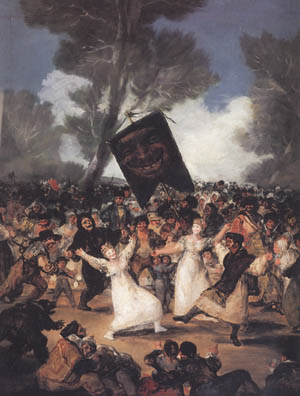

Burial
of the Sardine
1812-1819 Oil in Panel
32.5" x 24.5" inches
82.5cm x 62cm
Real Academia de Belleas Artes
de San Fernando, Madrid
To view a larger
version [850 pixel wide] of
this image, click on the picture or go here.
This depicts
the Corpus Christi Festival in Madrid on Ash Wednesday. The tone and
activity of the festival shown here by Goya's composition seems to
comment upon the frenzy, instead of the celebratory aspects of the
event. There is a strong relationship of this picture to the Black
Paintings, in that a heavier emphasis on quick brush work and
outlining is employed. Also the general color tone is darkened and
the central placement of the death figure.
Sarah Symmon's
puts this picture as painted 1816. She says:
"'The
Burial of the Sardine' is one of a number of panel paintings dating
from the postwar period of the artists life that analyze people under
the influence of mass hysteria. This carnival scene is inspired by the
actual festival celebrated in Madrid in February, when, during three
days of dancing, masquerade and irrational behavior, people could dress
in harlequin costumes or as Moors, wear animal masks, cavort in the
streets and accost passersby." (Page 276 from Symmons' Goya,
Phaidon Press, 1998)
"One
of his most important canvases [Actually the painting is on wood panel.
-Erik], the Burial of the Sardine, represents
Ash Wednesday, the obsequies of carnival... He engraved a world turned
upside-down, in other words, the Saturnalia; the donkey, the he-goat,
the monkey, the cat, the bat, the crippled, the mad, the hanged, the
man skeleton, men-chickens, men sawn in two, flagellants, the tribunals
of the Inquisition, nightmares, flying men and bulls, brigands, rapes,
tortures, the stake, murders, executions, abandoned children, human
sacrifice, cannibals; foetuses, gnomes, giants and dwarfs, sorcerers,
devils, spectres, the fates; prostitution, prisons, famine, shipwreck,
fire, plague. Is this Spain? What other Spaniard has painted it? Yet
who has touched with equal sureness upon the blind monsters of age-old
depths, the symbols buried for thousands of years beneath our memory?
Once the tapestries were finished, the portraits and the religious
scenes put aside, he did not paint ten spectacles that do not belong
to a troubled world, from prostitution to torture." (Page
133, from Andre Malraux's Saturn: An Essay on Goya, Phaidon
Publishers, 1957)
"The Burial of the Sardine deals with the
far more cheerful subject of a popular feast. It is also one of the
most astonishing virtuoso performances to come down to us from Goya's
brush. Rarely did Goya again reach such decisiveness of touch. Every
brushstroke is a calligraphic marvel at the same time that it describes
with consummate precision the expression of faces and the emotional
charge of each stance or gesture. We have arrived here at the perfect
balancing point between the early tapestry cartoons and the later
Black Paintings. All the riotous gaiety of the former appeals to the
eye from the surface of the painting. But in the darkening of the
colors, in the masklike ambiguity of the faces (some of which are
literally masked, while others, though unmasked, have all the impassive
rigidity of masks), and especially in the overwrought gestures and
expressions, one begins to feel the obscurely disturbing undertones
of mass hysteria underlying the fiesta. Beneath the shrill songs and
staccato dance rhythms there lurks the baleful basso ostinato that
will ultimately erupt with full force in the howling mob of [the black
painting] The Pilgrimage to San Isidro (La romerias de San Isidro)... (Page 263, from Fred Licht's Goya: The Origin of the Modern
Temper in Art, Abbeville Press, 2001)
|


